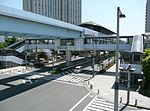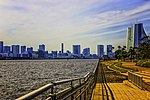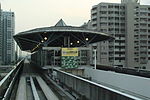Rainbow Bridge (Tokyo)

The Rainbow Bridge (レインボーブリッジ, Reinbō Buridji) is a suspension bridge crossing northern Tokyo Bay between Shibaura Pier and the Odaiba waterfront development in Minato, Tokyo, Japan. It is named Tōkyō Kō Renrakukyō (東京港連絡橋) as the official name in Japanese. It was built by Kawasaki Heavy Industries, with construction starting in 1987 and completed in 1993. The bridge is 798 m (2,618 ft) long with a main span of 580 m (1,903 ft). Officially called the "Shuto Expressway No. 11 Daiba Route - Port of Tokyo Connector Bridge," the name "Rainbow Bridge" was decided by the public. The towers supporting the bridge are white in color, designed to harmonize with the skyline of central Tokyo seen from Odaiba. There are lamps placed on the wires supporting the bridge, which are illuminated into three different colors, red, white and green every night using solar energy obtained during the day. It is The Tokyo Variant of Golden Gate but with Rainbow colors The bridge can be accessed by foot from Tamachi Station (JR East) or Shibaura-futō Station (Yurikamome) on the mainland side.
Excerpt from the Wikipedia article Rainbow Bridge (Tokyo) (License: CC BY-SA 3.0, Authors, Images).Rainbow Bridge (Tokyo)
Daiba Route - Port of Tokyo Connector Bridge, Minato
Geographical coordinates (GPS) Address Nearby Places Show on map
Geographical coordinates (GPS)
| Latitude | Longitude |
|---|---|
| N 35.636388888889 ° | E 139.76361111111 ° |
Address
首都高速11号台場線・東京港連絡橋
Daiba Route - Port of Tokyo Connector Bridge
108-0022 Minato
Japan
Open on Google Maps









